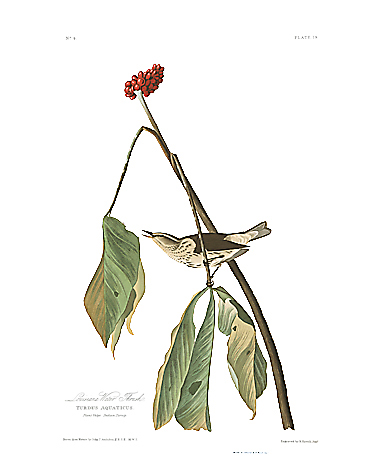|
Havell Name
Louisiana Water Thrush Common Name Louisiana Waterthrush Havell Plate No. 019 Paper Size 39" x 28" Image Size 16" x 9" Price $ 600 |
||||
|
Ornithological Biography Much and justly as the song of the Nightingale is admired, I am inclined, after having often listened to it, to pronounce it in no degree superior to that of the Louisiana Water Thrush. The notes of the latter bird are as powerful and mellow, and at times as varied.
This bird is a resident of the low lands of the States of Louisiana and Mississippi, and is to be found at all seasons in the deepest and most swampy of our cane-brakes, from which its melodies are heard to a considerable distance, its voice being nearly as loud as that of the Wood Thrush. The bird may be observed perched on a low bough scarcely higher than the tops of the canes, in an erect attitude, swelling its throat, and repeating several times in succession sounds so approaching two octaves of a good piano-forte, as almost to induce the hearer to imagine that the keys of that instrument are used on the occasion. The bird begins on the upper key, and progressively passes from one to another, until it reaches the base note, this last frequently being lost when there is the least agitation in the air. Its song is heard even in the winter, when the weather is calm and warm. The flight of this bird is easy, and continued amongst the trees, just above the canes, or closer over the ground, when it is passing along their skirts, gliding smoothly through the air. When alighted, its body is continually vibrating, the tail being at the same time alternately jerked out and closed again. It walks prettily along the branches, or on the ground, but never hops. It feeds on insects and larvae, often pursuing the former on wing, as well as on the ground, yet in seizing them it does not produce the clicking sound heard from the bill of Flycatchers. The nest of this species is commenced in the first days of April. It is placed at the foot and amongst the roots of a tree, or by the side of a decayed log, and is so easily discovered at times that my eyes have once or twice been attracted by it, whilst walking about in search of something else. The outer parts are formed of dry leaves and mosses, the inner of fine grasses, with a few hairs, or the dried fibres of the Spanish moss, which so much resemble horse-hair as scarcely to be distinguished from it. The female lays four or five eggs, and takes fourteen days to hatch them. When disturbed on her nest at an early period of incubation, she merely flies off; but if discovered towards the conclusion of that period, she is seen tumbling and rolling about, spreading her wings and tail, as if in the last agonies of despair, uttering all the while a most piteous tone, to entice the intruder to follow her. The young leave the nest in about ten days, and follow the parent from, place to place, on the ground, where they are fed until able to fly. I have not been able to ascertain whether this bird rears more than one brood in a season, but am inclined to believe that it does not. The eggs are flesh-coloured, sprinkled with darker red on the large end. During winter, it becomes so plump as to be a pure mass of fat, and furnishes extremely delicate eating. I have never seen this species farther eastward than Georgia, nor higher on the Ohio than the cane-brakes about Henderson. Dr. RICHARDSON states that this species was seen “at Carlton House, where it frequented the moist and thickly wooded points of the river. It arrived in May, and disappeared after a few days, probably going farther north to breed.” Mr. TOWNSEND informs me that it is common in the districts adjoining the Columbia river, but does not say whether it breeds there or not, although he states that it breeds on the Missouri. During my late journey to the Texas, my friend EDWARD HARRIS and my son JOHN WOODHOUSE procured a good number of these birds in the months of April and May. They were then migrating along the shores and islands of the Gulf of Mexico. In winter resident from Texas to Florida, including Louisiana. In summer migrates as far as the Fur Countries. Not abundant. |
|||||
|
|
|||||


| Home | Gallery | Audubon Biography | About Edition | Testimonials | Authorized Dealers | Links | Contact Us |

© Copyright 2007-2025 Zebra Publishing, LLC. | All Rights Reserved Terms of Use
Powered by Fusedog Media Group
